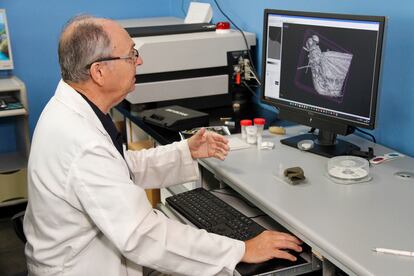Dr. Arnold Stanisic, who specializes in mayflies (or insects that have a life cycle of a few hours, a day or two at most), recalls Professor Alba Trsidor, who is also a specialist in this field, moreover, in microscopy . This, in turn, contacted Dr. Roman Goduncu, who specializes in these amber-preserved insects and has additional taxonomic experience who had previously described a new species. Finally, Professors Michel Grabowski and Thomas Rywicks who specialize in invertebrate DNA analysis were contacted. The result of this series of scientists was the classification of a new insect, andFor Calliarcys AnticusThe age is estimated between 35 and 47 million years. The animal was kept in a piece of amber 2.5 cm wide and about 1.5 cm high.
“In science, one does nothing alone.” This is the conclusion of Javier Alba Trsedore, Professor at Department of Zoology of the University of Granada, when he recalls the sequence of scientists that began, thanks to Stanegic’s curiosity and intuition, “four or five years ago,” says Alba Trsidor from his memory.
characterization Calliarcys Antiquus It was not a research project to use. No one went to a European entity looking for money or putting forward a hypothesis, he went out into the field with his team and back to the lab and compared his assumptions to reality to see if they were confirmed. It was a series of friendships and professional will. Stanisch d., from the State Museum of Natural History in Stuttgart (Germany), found a perfectly clear piece of amber from the Baltic Sea where a male mayfly was preserved – to be known later – in very good protected conditions. However, the insect, which was no more than 1 centimeter long, showed some vitreous areas (with a transparent vitreous appearance) that prevented it from being seen clearly.
The German researcher felt that this insect would have some extra interest and decided to continue the research. He then moved to Granada, with more than ten years of experience in computerized microscopy, which Alba-Tresidor called a “3D microscope” because thanks to 3D X-rays, it makes it possible to image X-ray objects, insects in this case, in successive segments. These pieces are in the microns, allowing, among hundreds of images, to generate a high-resolution 3D image of what is being x-rayed. In this case, the Calliarcys Antiquus, the new species, the professor has taken more than 1,000 photos of reconstructing an animal that is one centimeter long. “The bug was empty inside, probably due to some bacteria, but fortunately the skin it was covering at the time was very well preserved.”
For those things from life and science, not being a project to use, the images were stored and investigated in the background. The amber piece has long since returned to Stuttgart Museum Where you can see and there was everything. Until a year ago, Javier Alba took up the matter. After the “pros and cons” process inside the insect, the animal was reborn photographically in the form of a “beautiful 3D specimen,” says Alba Tresidor. The UGR researcher learned that the mayfly was a male of the genus Callyarcis, but soon realized that the species had not been identified, and that it was an animal that had not yet been classified.
Then Alba Trsidor turned to Roman Godonko of the Institute of the Czech Academy of Sciences in Ceske Budejovice. With his expertise in insects preserved in amber and having already described some species for the first time, Godunko confirmed that it was a new species and suggested a name to the researchers involved up to that time, who agreed: Callyarcis Antiquus, Older caliarsis, I. The final step was to conduct a molecular study of the current species – the heirs of the Anticus – to check phylogenetic convergence and see when those species became extinct to make way for the next. Intervening there Michal Grabowski and Thomas Rewich, researchers from the University of Lodz in Poland, and zoologists specializing in DNA studies. This discovery was published in Scientific Reportsposted online to the group temper natureon September 9.

Thus, “thanks to the enthusiastic cooperation of researchers and detective work, by five scientists distributed around the world,” explains Alba Tresidor, it resembles a small piece of amber from the Baltic Sea, the largest reservoir of amber deposits in the world. , which contained an insect trapped in it that went down in the short history of science. Amber, the thick and sticky liquid produced by plants such as conifers and some legumes in response to damage to their bark, is not only an involuntary hunter of insects, but fortunately for science, it has been a great preserver for millions of years.
You can follow issue in FacebookAnd the Twitter And the Instagramor sign up here to receive Weekly newsletter.
Subscribe to continue reading
Unlimited reading





